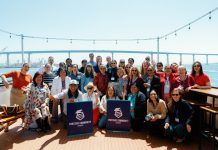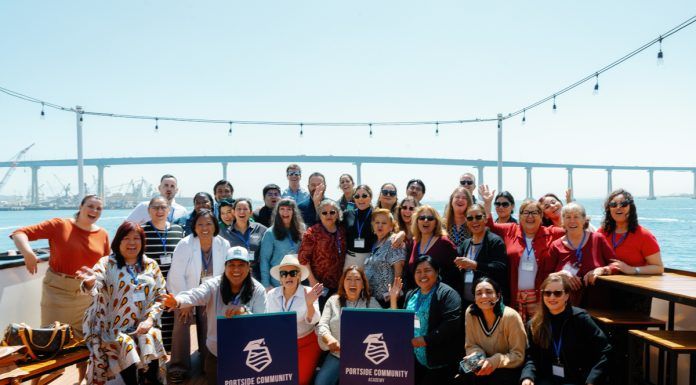With the spread of COVID-19, on March 19,2020, Gov. Gavin Newsom issued an executive stay-at-home order throughout the state to preserve public health and safety and to ensure the healthcare system could serve everyone and flatten the curve on the fast spreading virus.
Nearly everything stopped.
People were ordered to stay at home except for essential service providers. Local highways were empty, groceries store shelfs emptied as quickly as they could stock supplies, and most businesses shut their doors completely. Schools around the state, closed their doors in in-person learning beginning March 13, 2020. This came a month after San Diego County declared a local health emergency on Feb. 14, 2020.
During the height of the pandemic over the past year, the governor announced a second stay at home order that took effect on Dec. 3, 2020, in order to lower the curve of the spread of COVID-19 over the holiday season, for regions with less than 15% ICU availability. The governor lifted the second order on Jan. 25, after seeing a flattening of the curve.
By August 2020, the governor unveiled California’s four-colored tier system. San Diego County was able to move from the Purple Tier to the less restrictive Red Tier on March 16. This allowed many businesses to open their doors again, and many for the first time since the first stay-at-home order. Restaurants, movie theaters, museums, zoos and aquariums could begin resuming indoor operations at 25% capacity. Retail can increase indoor operations at 50% capacity, gyms and fitness centers at 10% capacity.

With vaccines on the rollout, San Diego County reached one million vaccinations on March 5, with nearly 16 percent of San Diegans age 16 and older fully immunized, and 23.1% receiving at least one dose of the two-dose regimens.
The county’s small businesses have been hit hard during the past year, with hundreds hanging in the balance. Many businesses have remained closed temporarily or permanently. Others have spent thousands of dollars in making their businesses COVID-19 safe, and though the county is now in the red tier, many businesses are deciding not to move towards indoor activities.
Chula Vista and National City have been severely hit by the COVID-19 pandemic, both in the number of cases and the impact the pandemic has had on the small business community.
Family House of Pancakes in National City, had to completely change its operations when the complete shutdown happened in March, said Manager Sebastian Spezzano. He said this was stressful, as it is a restaurant, and everybody visited to sit inside.
Spezzano said they had to lay off everyone except five employees, mostly the cooks, out of its 60 employees.
“Everybody had to go on EDD unemployment, and we were stuck with five people trying to hold down the restaurant for three months,” he said.
Spezzano said during that time, the restaurant only made about seven percent of sales, making it tough, but that staff worked with them and the community came out in support, so they started seeing higher sales with to-go orders, which really, he said, helped save the business.
“It has been stressful with all of the moving around,” said Spezzano. “We are open one day, and then we are closed the next. But we shifted to a more pandemic friendly business, and with the help of the community we are still thriving. We are still not fully staffed on the floor as we should be, but slowly but surely, we are coming back. We are back to 40 employees.”
Spezzano said it did get some funds from various government grants, and without that he does not think the restaurant would have stayed afloat. He said the restaurant had to make some investments to keep going.
“We had to invest more in sanitary equipment, gloves, masks,” he said. “We had to invest in outdoor dining, renting multiple tents, tables, chairs. We just had to get heaters because of the rain. Pretty costly, but we are still managing to thrive.”
Spezzano said now in the red tier, it is partially opened in the inside, at 25% capacity, along with the tents outside.
Spezzano said he believes the County is doing the best it can in dealing with the pandemic.
“I think it is hard to make those decisions being so high up and dealing with hospitals, emergency rooms overflowing with COVID patients,” he said. “It is understandable why they did what they did. It is hard for me to give suggestions. I am not in their position, and I do not know what information that they have.”
Spezzano said he hopes that the restaurant will keep moving forward, the COVID vaccinations work and that the county can continue to move up the tier levels and find normalcy. He said the National City Fire Department helped all employees who wanted to be, get vaccinated. He said things are looking up, but that the restaurant still has a way to go.
“I do not think we will break even at 25%,” he said. “Perhaps at 50%, but hopefully soon we can start seeing a boost in our numbers. We want everyone in the community to know that we appreciate their support, and what they have been doing for us during this pandemic.”
Family House of Pancakes has another location in Chula Vista on Broadway.
IT management President Bob Salomon said his IT business, CIO Systems, Inc, in Chula Vista, has been antipodean of everything else that has happened during the pandemic. He said CIO has been incredibly busy during the pandemic.
“Because we do IT services and all of our clients had to move all of their staff out of their offices. We have been remarkably busy getting everybody set up at home and getting computers set up,” he said.
Salomon said in the beginning, the biggest problem they faced was finding enough hardware.
“We had to scratch together all these used computers and rebuilt a lot, because we did not have enough computers,” he said. “There were not even enough computers in the inventory to purchase. We added a couple of people on temporarily to help us.”
Salomon said one of its clients in South Bay was busy and expanding during the pandemic, which added more work for the company. He said they deal with many healthcare people also, so finding work that needed to be done was not an issue.
“We are just now seeing a slowdown,” he said. “While everyone was slowing down, we were picking up and now that they are picking up, we are slowing down. It has been an interesting ride.”
CIO Systems is a hardware and network integrator. Salomon said fortunately, they had a lot of infrastructure in place, so the increase in demand was not hard because they were prepared.
“We did two years of work in two days,” said Salomon. “Our systems were robust, so other than getting hardware together, most things moved off site easily.”
With many companies embracing employees working out of their homes, Solomon said they will be able to provide that service. “All of our systems will have a tease to be able to do that in the future. I see this growing with the company now, with a steady healthy growth over the coming year as things get back in order,” he said.
Salomon said he liked to use his work with the Third Avenue Village Association as an example of what his company does.
“The nice people over at TAVA. Everybody was working out of the office,” he said. “They work all over the county. Something went wrong and they could not gain access to files in their office. Since they contract with me, I know their IT system. So, I was able to go in there and with the help of the maintenance team there, replace their system and got them up and running within a half an hour. They did not have to figure out who to call and did not have to worry about someone figuring out their system. What we do is be the IT department for companies that cannot afford their own IT department. We work closely with the companies that we manage their IT systems, know them, and safe them lots of money.”
In the Village area, when you put high school friends and artists Dewanna Dallas and Via Gary together, you get DVIA Art and Style, art, fashion, and interiors.
“Our studio is original fine art, wearable art clothing, shoes and we design wearable art earrings, and other fashion accessories,” said Gary. “We also recycle home accents. We might find an old basket, an old tray, an old table, and we upcycle it, paint it, change the whole function of it, or just increase the value of something that someone was just going to discard, but we decided to give it new life.”
Gary said in the beginning of the pandemic, they were just like everybody else. They closed their doors. And today, their studio doors are still closed.
“We stopped, we closed down and took the opportunity to reassess our business and praying that when we did open back up, we were still viable,” said Gary. “Over the years that we have been here we have been threatening to get our website done. This shutdown allowed us finally to get our online presence up and running. That is how we have sustained ourselves.”
Gary said that the two of them decided for themselves that they would not open the studio again until they get a little more assurance that they will not have to open and close repeatedly. She said they are both are caregivers for parents, so they are driving their business now to their website, Instagram and Facebook pages. Gary said they still work in the studio, and when they both feel the time is right, they will reopen their doors to the public again.
“We work in the studio, our fine art is hanging on the wall, bur now the online is helping us out while the studio is closed to the public,” said Gary. “But this is the main thing. It is the support of our husbands and our extended families. They do not want to see us fail. They want to see us succeed. They have been our lifeline to sustaining us here. The online is still new and we are still learning our way around it. Since COVID, we miss all our vending. We did jazz festivals and other events like that. Online is a cushion, but our families are our greatest supporters. We are blessed.”
Gary said they love Chula Vista, live 15 minutes away from the studio, and that Third Avenue is the perfect location for them.
“Initially when we were looking for a business, we looked in North Park and other areas, but when we got on the freeway, we just turned around and came back and decided to keep looking in Chula Vista. And we finally found this space,” she said.
But Gary said there is something extra special about 231 Third Ave.
“We are all women owned businesses,” she said. “There are five suites here, plus Ace Parking, but out of the five suites, we are all women owned businesses. It has been a wonderful experience really coworking with these ladies. We really support each other, we look out for each other, even more so during this pandemic.”
Gary said that their studio is as unique as what the studio offers, and they are both looking forward to opening the studio to the public again,
“At our studio gallery boutique, we purpose it as multi-cultural,” said Gary. “When we are open, we showcase and highlight any artisan. No background, ethnicities matter if they crafted their work and it matched our brand, we share their wares in our store. So, we have things from Japan, Africa, Native American, Hispanic culture. We have a full gamut of things here and we are proud of that and we have been received well in Chula Vista. Living here and working on Third Avenue has been wonderful. We feel like we got in here right in time considering all the changes going on Third Avenue. We feel privileged to be here.””
Dr. Ana Cluff, D.D.S., practices family and cosmetic dentistry. San Diego Health Smiles has two locations, one in Chula Vista, and the other in Lakeside. She said working the two locations, she has her daughter, Dr. Diana Cluff, and her daughter’s soon-to-be husband Dr. Michael Payor as associates in the business. Cluff said they did not close either location at the beginning of the pandemic, already having safety protocols in place.
“That is why we were able to stay open,” she said. “And we were able to see a lot of patients and new patients, because many dental offices closed. Stayin open, I had the full support of my staff. Most of my staff stayed with me through the entire year, and we were able to help many people.”
Cluff said not knowing what to do in the beginning of the pandemic, they prepared by following the guidelines given by the American Dental Association, California Dental Association and the San Diego County Dental Society.
“They gave us instructions on sanitization for all equipment and surfaces, barriers needed, and everything we needed to do to keep us safe and our patients,” she said. “We did not allow companions to come into the office. We only saw patients that had appointments for the day.”
Cluff said both offices were already separated by walls and a private entry between chairs, so patients were more than 10 feet apart.
“So, we did not have the social distance problem,” she said. “Together with covering all equipment, the barriers, sanitizing to prevent cross contamination completely after each patient, we actually saw a big influx of new patients coming because we were open and willing to help anyone.”
With respect to existing patients, Cluff said there was a mixed reaction, especially with the older population.
“They stepped down until they were aware of what we did to keep patients safe,” she said. “I have patients that have been with me for 10 to more than 15 years and they were confident that we would do our best to protect our customers and our staff receiving patients. Patients scheduled for regular cleanings and preventive dentistry slowed down, waiting for more guidance.”
Cluff said in the industry, they use many machines, suction and aerosols, and with all the treatments the dentistry scope of practice was provided throughout the entire year.
“The ADA, CDA and SDCDS gave more than instructions, they provided the guidelines that we have to follow, period,” she said. “We have always followed OSHA requirements. This is not anything new for us. This is something that we always must comply with. The ADA provided us with an extra set of tools and guidelines to be more protective, because the virus was something unknown on bad the transmission between people occurred.”
Cluff said now, everyone is trained about COVID-19. All doctors and staff had to take online classes on awareness, how to protect themselves and patients when they come into the office.
“The SDCDS provided us with PPE, masks, gloves, barriers, which was a big help guiding us on how we could go a step further protecting ourselves and our patients. It was all free. When everyone was looking for N-95 masks, we had plenty,” she said.
Cluff said the only problem they face is that personnel working the front desk had to stay home during the shutdown because they had children in school, and when schools shut down, they needed to be home.
“That was rough,” she said. “All of a sudden, I had four to five people that took care of different things in the office. I had to equip some of them to work from home to have contact with the office software to help us with billing, insurance, confirming appointments, conferring with other doctors with patients with other medical issues. They did a great job, but I had to provide them with computers, printers, phones, but it made things much easier for us here in the office.”
Cluff said they are now seeing more people coming back for preventive treatment and that she always promotes a healthy oral environment.
“Your mouth is the window to the rest of your body,” she said. “We have a steady consistency of patients for pre-care. Patients are beginning to feel safer. Most of my adult patients are over 80 and now vaccinated. All of us as health providers are immunized. We provided all the information to all our staff the information to be vaccinated. I have only encountered a handful of patients that are not quite sure they feel comfortable getting the vaccine.”
Cluff has been a dentist for more than 30 years and said she considers her profession an integral resource and service for all people. She said everyone needs to have a healthy mouth and healthy gums.
“And it is important that we follow all the guidelines,” she said. “I see around 20 patients a day. That patient only sees me, and who is assisting. It is important for people to know that we are doing everything possible, and more, to ensure the safety and wellbeing of our patients, and ourselves. There is no other way to do this. We do not want the pandemic to continue, we want to get it under control.”
Dolores Humphrey, owner of Community Mortuary on Broadway, said like everybody else, they had to change the way they did things due to the pandemic. She said people must wear masks, stay socially distanced, but that fortunately, they have a way for clients to do much of the planning, contracts and other services virtually.
“They do not have to leave home, be around other people, which makes them feel a little safer,” she said. “That works best if they are doing a simple cremation. Signatures and disclosures can be done online.”
Humphrey said that people who want larger services, with viewings, was impacted the most. She said because people are used to coming in the evening, staying for visitations with family and friends and loved ones, now it is all taking place in the daytime.
“We have stopped doing viewings at night because everyone should be at home with their families during the pandemic, and for us it is a little more controllable during the day,” she said.
Humphrey said the mortuary had to lessen the amount of people that gather inside in the chapel, so depending on the restrictions or tier in place, it was always an adjustment and that they never really know how many people will show up.
“When there are more people that we can allow, we placed chairs outside where they can gather under a covered carport with shade so they can gather there,” she said. “We are following the guidelines and we can spread the chairs out, and they are not all gathering in the chapel. Churches were implementing this as well, with services being held in parking lots so people can spread outside. It has really been our daily work, just in a different way.”
Community Mortuary had livestream services available before the pandemic. Humphrey said this abruptly stopped as soon as the stay at home order began.
“Coincidently, because everyone was staying at home, working from home, schooling from home, the demand on the internet in our area was so high, the cables were saturated,” she said. “Our phones were not working, our livestream would not work, because it is all through cable. When we needed it most, our livestream would not work. Eventually, after a few months, the cable company came out and split a node in our neighborhood that evened out the demand and the flow of what people needed. So, we are back in order and my livestream works again. But that was another hiccup the pandemic caused. Things were pretty messed up. I was putting the business lines on my cellphone because it was not through cable.”
Humphrey said she understands how hard Chula Vista has been hit by the pandemic and that the mortuary saw a huge surge of people coming in. She said at one point and time, they had to turn some people away because they did not have the accommodations to bring anyone else into their care.
“The state has many rules and laws on how we can store remains and it was getting to the point where we were unable to comply if we took anymore in. We had to turn business away,” she said.
But the mortuary is still extremely busy with the families that it is assisting. Humphrey said people are so understanding, knowing that they must wait.
“It has been a long wait sometimes to get done what we need to do so we can move forward with what they want. COVID was spreading so quickly, the staff at various places were splitting,” she said. “Some were not coming in making sure they were well if their staff members got sick. It had to be someone who was willing to come in and do whatever. Some places petitioning for help were waiting forever because they had a lower staff level, just for precautionary purposes. Things domino around different ways, trying to catch up with what was falling.”
Humphrey said that it has “eased a little bit for now,” it is not quite as demanding, and she hopes it stays that way. She said she hopes that by lowering the tier a bit, that people keep things under control instead of thinking everything is okay because they are allowing less restrictions.
“We have been very blessed,” said Humphrey. “Nobody has had to leave because they had COVID. One person was informed they had been exposed to someone who was positive, and they had to quarantine until their test came back, which was negative. That was just three or four days. We have been incredibly lucky, and I hope that we can keep on paddling.”
Community Mortuary is a full service mortuary with cremation, full body, services, preplanning, transporting and all end of life services. “We try to exceed expectations, but more than that, we are a mortuary that cares. We are here to help,” said Humphrey.
Mathnasium of Eastlake is the only “math only” learning center in Chula Vista. Mathnasium is a national chain. Owner Doug Wolf said his site has been open since December 2008, serving around 1,700 children.
“We help those that are falling behind, those that just need a little push to stay on track and helping those that are doing well and thriving but are not challenged enough,” said Wolf.
Wolf said when the shutdown happened, and schools closed the second half of March of last year, it closed its doors entirely. But by April, Mathnasium was able to help kids virtually through an online platform that corporate headquarters launched, something that was already in process before the shutdown.
“That worked pretty well,” said Wolf. “We were able to see about 30 to 35 kids a day online for the parents that wanted them to continue their studies during that time. When the city loosened some restrictions in June for limited capacity and other restrictions, we were able to reopen for face to face instructions and have been doing that since. Some kids are still doing online, but most have come back along with new kids for face to face. With spacing distance, we are seeing a much lower capacity than normal which has kept us afloat and alive.”
Wolf said during that time, he did not cut back on marketing, did not furlough or lay off any staff, and even with limited hours, he was able to keep staff with as many hours as he could. He said that most of them are now back to pre-shutdown level of hours and employment. Wolf said he is happy that they are still able to help kids coming in-person.
“I am extremely grateful to the parents that stuck by and came in,” said Wolf. “Even when we were closed completely, some parents said that they knew we were closed, but to keep charging them because they wanted me to stay open and stay afloat. Being 12 years here in the community, I think we have built a very loyal group of customers, but really, I think more of them like a family. Our reputation here is great because we have been here so long and helped so many kids. That is my only intention. Helping the kids and helping them improve and get better.”
Wolf said on an operating basis, the business is doing okay, and he is not losing money. He said it is not strong enough to him personally to live like it was before the pandemic, but he is covering expenses.
“I am covering my rent. I had help from my landlord and I am grateful for that. It obviously helped us stay afloat,” said Wolf. “I would not say that we are thriving by any stretch of the imagination, but we should be okay. The schools are slated to come back in the next couple of weeks after spring break. That will be a help. I think as parents can send their kids back to school, they will feel more comfortable having their kids go out to places. That should be a boom to people coming back.”
Wolf said with distance restrictions and how many students they can see in an hour might cause some problems, but he is already thinking of extending Mathnasium’s hours to accommodate for more kids. He said the CDC recommendation reducing student social distancing to three feet will allow him to see more students also.
“I follow the city’s guidelines on distancing, masks, wiping surfaces in between,” he said. “I did not need barriers because I am able to social distance them according to the guidelines. Since I am only able to see half of what my normal capacity is, as parents are enrolling, and the need for math help has not gone away, with kids out of school, parents do not feel that their kids are getting the instruction they need. They have fallen behind. We all know education has suffered for the kids, and many have no choice but to seek outside help. I am grateful, being the only math only learning center here in Chula Vista, they naturally seek out the one that has been here for 12 years and has phenomenal five star ratings. I think that is because the parents know that we always put the child’s needs first.”















